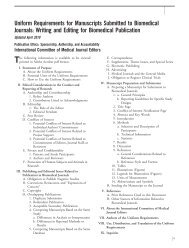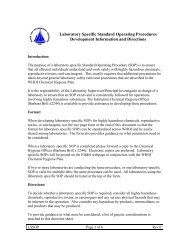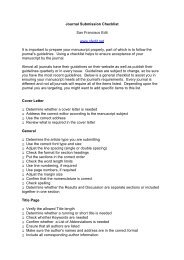Guidance for Preparing Standard Operating Procedures (SOPs)
Guidance for Preparing Standard Operating Procedures (SOPs)
Guidance for Preparing Standard Operating Procedures (SOPs)
Create successful ePaper yourself
Turn your PDF publications into a flip-book with our unique Google optimized e-Paper software.
3.2 Table of Contents<br />
A Table of Contents is needed <strong>for</strong> quick reference <strong>for</strong> locating in<strong>for</strong>mation and to denote<br />
changes or revisions made only to certain sections of a SOP.<br />
3.3 Text<br />
Well-written <strong>SOPs</strong> should first briefly describe the purpose of the work or process,<br />
including any regulatory in<strong>for</strong>mation or standards that are appropriate to the SOP process. Define<br />
any specialized or unusual terms either in a separate definition section or in the appropriate<br />
discussion section. Then denote the sequential procedures to be followed, divided into significant<br />
sections; e.g., equipment needed, personnel qualifications, and safety considerations. Describe<br />
next all appropriate QA and quality control (QC) activities <strong>for</strong> that procedure, and list any cited or<br />
significant references.<br />
As noted above, <strong>SOPs</strong> should be clearly worded so as to be readily understandable by a<br />
person knowledgeable with the general concept of the procedure, and the procedures should be<br />
written in a <strong>for</strong>mat that clearly describes the steps in order. Use of diagrams and flow charts help<br />
to break up long sections of text and to briefly summarize a series of steps <strong>for</strong> the reader.<br />
Attach any appropriate in<strong>for</strong>mation; e.g., a SOP may reference other <strong>SOPs</strong>. In such a case,<br />
the following should be included:<br />
1. Cite the other SOP and attach a copy, or reference where it may be easily located.<br />
2. If the referenced SOP is not to be followed exactly, the required modification<br />
should be specified in the SOP at the section where the other SOP is cited.<br />
More in<strong>for</strong>mation on text is contained in Section 4.1 <strong>for</strong> Technical <strong>SOPs</strong> and Section 4.2 <strong>for</strong><br />
Administrative <strong>SOPs</strong>.<br />
4. TYPES OF <strong>SOPs</strong><br />
<strong>SOPs</strong> may be written <strong>for</strong> any repetitive technical activity, as well as <strong>for</strong> any administrative<br />
procedure, that is being followed within an organization. General guidance <strong>for</strong> preparing both<br />
technical and administrative <strong>SOPs</strong> follows and examples of each are located in the Appendix.<br />
4.1 Technical SOP Text In<strong>for</strong>mation Guidelines<br />
Technical <strong>SOPs</strong> can be written <strong>for</strong> a wide variety of activities. Examples are <strong>SOPs</strong><br />
instructing the user how to per<strong>for</strong>m a specific analytical method to be followed in the laboratory or<br />
field (such as field testing using an immunoassay kit), or how to collect a sample in order to<br />
preserve the sample integrity and representativeness of the area of concern (such as collection of<br />
samples <strong>for</strong> future analysis of volatile organic compounds or trace metals), or how to conduct a<br />
bioassessment of a freshwater site. Technical <strong>SOPs</strong> are also needed to cover activities such as<br />
QA/G-6 5<br />
March 2001







